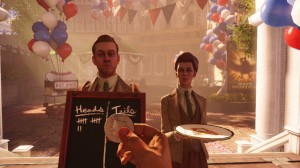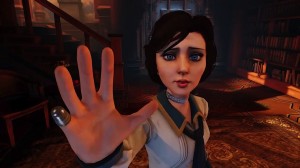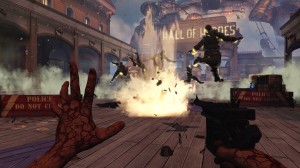
“Bring us the girl and wipe away the debt.” A straightforward premise that will be the driving force behind all the upcoming events of Bioshock Infinite. It’s not at all clear who this girl is exactly, and why “they” need him to bring her back to New York. However, this is the last chance for private investigator Booker DeWiit, a man whose troubled past has lead to an excessive lifestyle of drinking and gambling. It doesn’t sound like a particularly challenging task for a man of his skillset, but then again, he also had no idea where he would be required to go.
It is an adventure that will take players away from the depths of Rapture, and instead to the floating city of Columbia. Launched by the United States of America in 1901, this scientific marvel of quantum levitation and giant balloons was intended to be a traveling world fair, whilst clearly representing the growth of American exceptionalism at the same time. However, what started out as an endeavour of hope, quickly turned sour when the dangerous and violent potential of the city was revealed to the public. The events proceeding these revelations lead to escalating issues between Columbia founder Zachary Comstock and the US government, forcing the leader to secede from the country and take the city high above the Clouds, never to be seen again.
At this point, it all sounds reasonably straightforward, but it isn’t long after Booker takes his first steps into the city that it quickly becomes apparent that Columbia is anything but that. Having been caught in the middle of a civil war, the player learns that the population has split into two main factions. On one side, the fanatically religious Founders led by “Prophet” Zachary Comstock, and on the other the underground insurgency Vox Populi, lead by revolutionist Daisy Fitzroy. It is then within all this mess that Booker is expected to retrieve the girl, and return her to New York. However, as it turns out this particular girl is actually the sole heir to the Prophet, and to make matters even worse, his purpose in Columbia was somehow prophesied to the people prior to his arrival.
Introducing players to Rapture for the first time in the original Bioshock has arguably become one of the most critically acclaimed moments in gaming history, so it certainly begs the question whether Irrational Games still had the creative drive to capture our imaginations for a second time. Fortunately, the answer to this question is remarkably positive as despite some common similarities with the original, Bioshock Infinite is equally successful in delivering a truly unique and believable world.
Now it’s certainly possible that some players might be initially disappointed with the opening launch to Columbia as it’s not quite as grand an introduction when compared to it’s predecessor. However, this was also by intentional design as whilst both cities were founded by excentric ideologists, those two ideologies almost serve as complete opposites to one another. Columbia, or New Eden as it is so biblically referred to, is very closely tied with a fanatical representation of religion and exceptionalism, which leads us to believe that the designers wanted to humble the player during these opening sequences before actually introducing them into the awe inspiring world that awaits on the other side.
This is clearly the type of game that knows exactly what it’s trying to tell you, and whilst you might not initially understand all the information you’re receiving at first, it’s remarkable how well realised the narrative and game world are with one another. As from the moment you step into the city for the first time, it is truly inspiring how much life surrounds you by simply walking down the road. It is for this reason that the urge for exploration comes so naturally to the player, but at the same time we need to recognise that Infinite only provides the illusion of an open-world. There is still a lot for players to see and investigate for themselves during their stay in Columbia, but due to the ever-forward nature of the plot, your interaction with the world does become somewhat limited.
With all that being said, it’s particularly interesting to note that this may not have always been the designers original intention. In earlier segments of the game before the plot has a chance to take off, the world is actually presented in a far more open fashion, with decisions for the player to make and consequences that seemingly resulted from those actions. However, it isn’t long after the shooting begins that this concept takes a back seat, and the core focus is instead shifted to keeping the player moving forward. This change in direction doesn’t quite hurt the overall experience, but it did leave us questioning whether our actions would eventually affect the outcome of the game. Ultimately, they didn’t, but it’s evident this decision was in part due to design limitations or possibly because the focus on narrative simply couldn’t allow for this approach to be done well.

It’s certainly reasonable at this point to assume Bioshock Infinite struggled to find it’s way at first, although this was not entirely surprising with several delays experienced during development. However, whilst there are a still a few early seams that can be seen within the design patchwork, that’s not to say the final product didn’t develop into an outstanding piece of artwork, and we say that quite confidently. What we have here is a brilliantly designed game that still provides enough freedom to keep things entertaining, whilst driving an invigorating plotline that will hold your attention through till the end. And up until this point we have not even discussed the actual star of this show, a young lady that is undeniably charming and whom will be accompanying you throughout the entire game.
Elizabeth is truly a product of intricate design, and it’s clear that she was always intended to be one of the major draws to the game. It would simply damage the experience to go into too much detail, but essentially what she is capable of doing is tearing windows into many alternate realities. This ability can then be controlled by the player during combat and used to pull objects across to reshape the battlefield. It’s a unique and engaging mechanic, and whilst the player remains pre-occupied with shooting, she will then go out in search of additional ammo, salts & currency to throw across to you when it’s needed most. It’s a incredible achievement that Bioshock Infinite so clearly avoids becoming a large escort mission, and we expect that Elizabeth will be the topic of many discussions to come.
Whilst the original Bioshock was very well known for it’s artistic design, it was also the unique mix of roleplaying and shooter gameplay mechanics that earned a lot critical acclaim. This of course meant the sequel would be required to experiment with these ideas to, and fortunately there are many inspired concepts that return from the original. The first of which are a series potions known as Vigors, which are essentially a re-worked version of the Plasmid that the player can drink to gain special abilities. There is no definitive science behind how these work, besides the fact that the player will need a consumable resource known as “Salt” to use them.
Ultimately, the overall design of Infinite provides a far more streamlined experience than it’s predecessors, with more guns blazing and a lot less micro-management. And whilst this direction could be negatively received by fans, it has also opened the door to innovations in gameplay such as interchangeable gear that can provide special perks in combat, and a grapple hook to travel across the many sky rails that exist throughout the city. In addition to this, there are also upgrades known as Infusions that are hidden throughout Columbia, each of which can be used to increase Health, Salts or the Shield. It is a little disappointing that all of the other upgrade options were simply lumped into various vending machines, but at the end of the day all these mechanics come together perfectly to create a succinct experience that strongly encourages exploration without ever burdening the player.
When investigating the actual gameplay itself, we can say with absolute confidence that it’s an incredibly well built game. The grapple mechanic which is used for melee combat and high take downs from the sky-rails above certainly keeps things interesting as does the many clever combinations of Vigors and gunplay available to the player. It is worth noting that Bioshock Infinite is not a remarkably challenging game, but we also believe this approach was intentional as to ensure more people would see the story through to the end. However, upon completion players will unlock what is known as “1999 Mode”, a special setting that provides a significant increase in difficulty and forces a lot more consequences and restrictions onto the player. It’s clear this was not simply an afterthought, and serves as an excellent example of Irrational Games dedication to the entire fanbase.
Graphically speaking Bioshock Infinite is a good looking game, with only the console versions starting to show the age of their respective platforms. However, this is a series that has become critically renown throughout the industry as digital art, and just like it’s predecessor, infinite displays no shortage of artistic vision. The world of Columbia is just so beautifully realised, and it’s way too easy to get lost in the ambience of the surrounding environment. It is filled with such an incredible amount tiny detail, that it’s almost mind boggling to think how much work went into realising this potential. However, this artistic vision is also complimented by an outstanding composition from Garry Schyman that takes the experience to a whole new level. The special thing about this particular musical score is the way the designers have integrated so many little queues into the music that can actually react in realtime to what the player was doing in the game. Of course, the soundtrack is fantastic, but this level of design is an incredible achievement and deserves it’s own recognition.
A truly remarkable achievement associated with the Bioshock Franchise is Ken Levine’s continuing ambition to convey deep and engaging stories without the use of a single cutscene. It is not the first time that Irrational have pushed the boundaries of game narrative, and it’s clear that the goal behind Infinite was to naturally immerse players into Columbia using as little effort as possible. The narrative will again make good use of audio diaries, which now work in conjunction with a series of short propaganda films called kinetescopes. However, what makes Columbia so relatable is the fact that there will no longer be a constant confrontation. This allows for the player to take in the environment around them and learn new things about the world by just experiencing the actions of all the other characters going about their business, reading the period appropriate propaganda that covers the city, and also conversing in regular dialogue with your unique and gifted companion Elizabeth.
Bioshock Infinite is truly something special, and whilst it’s evident in the final product that the game struggled to find an identity during the early stages of development, it still comes together perfectly to create a unique world that feels so natural to be a part of. Elizabeth is an absolutely wonderful companion, and it’s obvious how much love and attention to detail went into her character. This is not a perfect game technically speaking as there are still many problems and compromises riddled throughout the experience. However, it sometimes takes a certain combination of imperfections to truly make something special, and that is exactly how we feel about Bioshock Infinite. With an outstanding cast of characters, compelling world and a narrative that will almost certainly blow your mind when the final curtain draws, this is just one of those games we recommend everybody should play.

















